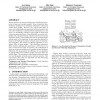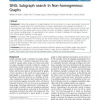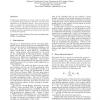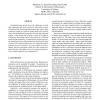119
Voted
CIKM
2010
Springer
14 years 7 months ago
2010
Springer
Recent advances in data processing have enabled the generation of large and complex graphs. Many researchers have developed techniques to investigate informative structures within...
126
click to vote
TVCG
2008
15 years 14 days ago
2008
Graphs have been widely used to model relationships among data. For large graphs, excessive edge crossings make the display visually cluttered and thus difficult to explore. In thi...
122
Voted
BMCBI
2010
15 years 21 days ago
2010
Background: Finding the subgraphs of a graph database that are isomorphic to a given query graph has practical applications in several fields, from cheminformatics to image unders...
116
click to vote
APVIS
2001
15 years 2 months ago
2001
Visualisations implemented as virtual worlds can allow users to comprehend large graphs more effectively. Good 3D layout algorithms are an important element. Angle has been develo...
107
click to vote
GD
2006
Springer
15 years 4 months ago
2006
Springer
We present a novel sampling-based approximation technique for classical multidimensional scaling that yields an extremely fast layout algorithm suitable even for very large graphs....
122
Voted
ICCTA
2007
IEEE
15 years 4 months ago
2007
IEEE
We have carried out experimental research into implicit representation of large graphs using reduced ordered binary decision diagrams (OBDDs). We experimentally show that for grap...
110
click to vote
IWPC
2000
IEEE
15 years 5 months ago
2000
IEEE
Call graphs are commonly used as input for automatic clustering algorithms, the goal of which is to extract the high level structure of the program under study. Determining the ca...
115
click to vote
GD
2004
Springer
15 years 6 months ago
2004
Springer
Large graphs are difficult to browse and to visually explore. This note adds up evidence that some graph drawing techniques, which produce readable layouts when applied to medium-s...
119
Voted
IV
2005
IEEE
15 years 6 months ago
2005
IEEE
Visualising large graphs faces the challenges of both data complexity and visual complexity. This paper presents a framework for visualising large graphs that reduces data complex...
121
click to vote
HIPC
2007
Springer
15 years 6 months ago
2007
Springer
Abstract. Large graphs involving millions of vertices are common in many practical applications and are challenging to process. Practical-time implementations using high-end comput...




